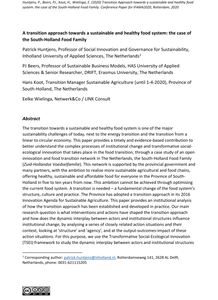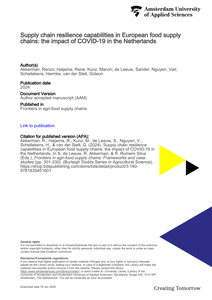Supply chains have inherent risk given the number of actors that interface. While there are some chains that have low frequencies of unfavorable events, many continuously face uncertainty. Food production has many uncertainties along the global supply chain. The global nature of the large logistical networks increases its complexity. Two main sources of uncertainty arise: External and internal to the SC. External factors mainly come from nature (such as "El Niño" phenomenon) and from human activities (such as food and nutrition policy and standards). Internal factors mainly come from operations such as a cold chain disruption. Thus, one needs to minimize risk and improve resilience in order to achieve food security and sustainability. It is then imperative that risk management practices be integrated into the supply chain design and management process. This chapter presents an overview of the main risks involved in global food supply chains, as well as some techniques for risk management.
DOCUMENT
This publication follows and analysis the proces in the region Westerkwartier in the Netherlands in their effort to built a whole new regionale food chain. In this report there is a remarkeble role for the knowledge instutions on vocational and applied level.
DOCUMENT

In het kader van het Interreg North Sea Region project "RIGHT skills for the RIGHT future" is een rapport geschreven waarin het concept waardeketens (value chains) en de ontwikkeling daarvan in de energiesector verkend is.
DOCUMENT

The transition towards a sustainable and healthy food system is one of the major sustainability challenges of today, next to the energy transition and the transition from a linear to circular economy. This paper provides a timely and evidence-based contribution to better understand the complex processes of institutional change and transformative social-ecological innovation that takes place in the food transition, through a case study of an open innovation and food transition network in The Netherlands, the South-Holland Food Family (Zuid-Hollandse Voedselfamilie). This network is supported by the provincial government and many partners, with the ambition to realize more sustainable agricultural and food chains, offering healthy, sustainable and affordable food for everyone in the Province of South-Holland in five to ten years from now. This ambition cannot be achieved through optimising the current food system. A transition is needed – a fundamental change of the food system’s structure, culture and practice. The Province has adopted a transition approach in its 2016 Innovation Agenda for Sustainable Agriculture. This paper provides an institutional analysis of how the transition approach has been established and developed in practice. Our main research question is what interventions and actions have shaped the transition approach and how does the dynamic interplay between actors and institutional structures influence institutional change, by analysing a series of closely related action situations and their context, looking at 'structure' and 'agency', and at the output-outcomes-impact of these action situations. For this purpose, we use the Transformative Social-Ecological Innovation (TSEI)-framework to study the dynamic interplay between actors and institutional structures influencing institutional change. The example of TSEI-framework application in this paper shows when and how local agents change the institutional context itself, which provides relevant insights on institutional work and the mutually constitutive nature of structure and agency. Above institutional analysis also shows the pivotal role of a number of actors, such as network facilitators and provincial minister, and their capability and skills to combine formal and informal institutional environments and logics and mobilize resources, thereby legitimizing and supporting the change effort. The results are indicative of the importance of institutional structures as both facilitating (i.e., the province’s policies) and limiting (e.g. land ownership) transition dynamics.
DOCUMENT

Short Food Supply Chains (SFSCs) are gaining attention for their potential economic, environmental, and social benefits. However, they remain hindered by their small scale and lack of efficiency. This study explores the digital readiness of SFSC suppliers and assesses the potential impact thereof on the SFSC’s ability to scale up and gain efficiency. Through an embedded case study design, the study findings highlight a lack of digital readiness of SFSC actors. Their focus on personal relationships and internal processes is found to be incongruent with digitalization as an enabler of SFSC performance.
DOCUMENT
This chapter discusses supply chain management responses used by companies in the food supply chain during the recent COVID-19 pandemic. The chapter first discusses the relevant literature on supply chain resilience. The chapter subsequently reviews supply chain responses in relation to different supply chain resilience capabilities, and then discusses the theory and practice of supply chain capabilities in food supply chains.
MULTIFILE

This chapter proposes sustainable supply chains in agrifoods, achieved through logistical strategies to minimize food waste and losses. Proposals will recover organic and inorganic waste and reincorporate it into the supply chain or add it to new chains through new products generated from food waste. A literature review is presented regarding the causes of food losses and waste within the supply chain and the strategic opportunities in the logistical process to reduce such losses. The creation of models that include the three dimensions of sustainability in food logistics is required in order to achieve a reduction in waste and food losses in transport, as well as to minimize costs and environmental impacts. If a correct sustainable logistics is carried out, it would favor the reincorporation of waste into new supply chains.
DOCUMENT
Purpose: Food waste occurs in every stage of the supply chain, but the value-added lost to waste is the highest when consumers waste food. The purpose of this paper is to understand the food waste behaviour of consumers to support policies for minimising food waste. Design/methodology/approach: Using the theory of planned behaviour (TPB) as a theoretical lens, the authors design a questionnaire that incorporates contextual factors to explain food waste behaviour. The authors test two models: base (four constructs of TPB) and extended (four constructs of TPB plus six contextual factors). The authors build partial least squares structural equation models to test the hypotheses. Findings: The data confirm significant relationships between food waste and contextual factors such as motives, financial attitudes, planning routines, food surplus, social relationships and Ramadan. Research limitations/implications: The data comes from an agriculturally resource-constrained country: Qatar. Practical implications: Food waste originating from various causes means more food should flow through the supply chains to reach consumers’ homes. Contextual factors identified in this work increase the explanatory power of the base model by 75 per cent. Social implications: Changing eating habits during certain periods of the year and food surplus have a strong impact on food waste behaviour. Originality/value: A country is considered to be food secure if it can provide its citizens with stable access to sufficient, safe and nutritious food. The findings and conclusions inform and impact upon the development of food waste and food security policies.
MULTIFILE
High-tech horticulture production methods (such as vertical farming, hydroponics and other related technology possibilities), combined with evolving market side possibilities (consumer’s willingness to pay for variety, food safety and security), are opening new ways to create and deliver value. In this paper we present four emerging business models and attempt to understand the conditions under which each business model is able to create positive market value and sustained business advantage. The first of these four models is the case of a vertically integrated production to retail operation. The second model is the case of a production model with assured retail/distribution side commitment. The third model deals with a marketing/branding driven production model with differentiated market positioning. Finally, the forth is a production model with direct delivery to the end-consumer based upon the leveraging of wide spread digital technology in the consumer market. To demonstrate these four business models, we analyze practical case studies and analyze their market approach and impact. Using this analysis, we create a framework that enables entrepreneurs and businesses to adopt a business model that matches their capabilities with market opportunities.
DOCUMENT
